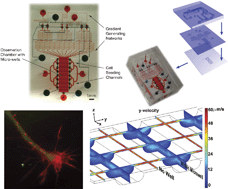Neuronal growth cones contain sophisticated molecular machinery precisely regulating their migration in response to complex combinatorial gradients of diverse external cues. The details of this regulation are still largely unknown, in part due to limitations of the currently available experimental techniques. Microfluidic devices have been shown to be capable of generating complex, stable and precisely controlled chemical gradients, but their use in studying growth cone migration has been limited in part due to the effects of shear stress. Here we describe a microfluidics-based turning-assay chip designed to overcome this issue. In addition to generating precise gradients of soluble guidance cues, the chip can also fabricate complex composite gradients of diffusible and surface-bound guidance cues that mimic the conditions the growth cones realistically counter in vivo. Applying this assay to Xenopus embryonic spinal neurons, we demonstrate that the presence of a surface-bound laminin gradient can finely tune the polarity of growth cone responses (repulsion or attraction) to gradients of brain-derived neurotrophic factor (BDNF), with the guidance outcome dependent on the mean BDNF concentration. The flexibility inherent in this assay holds significant potential for refinement of our understanding of nervous system development and regeneration, and can be extended to elucidate other cellular processes involving chemotaxis of shear sensitive cells.

You have access to this article
 Please wait while we load your content...
Something went wrong. Try again?
Please wait while we load your content...
Something went wrong. Try again?


 Please wait while we load your content...
Please wait while we load your content...